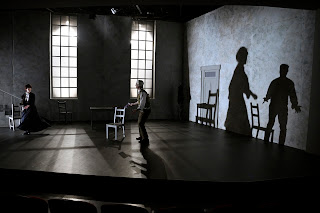 |
Lainie Hart as Nora, Rhys Robinson as Torvald
in Lucas Hnath's A Doll's House, Part 2 |
Dolls House 2 by Lucas Hnath.
Directed by Joel Horwood. Set
design Tom Berger. Lighting design Lachlan Houen. Sound design Neville Pye.
Costume design Helen Drum. Properties Coordinator Rosemary Gibbons. Stage
manager Carmen King. Production Manager Liz de Toth. Set Coordinator. Russell
Brown OAM Canberra Repertory Theatre. June 13-28 2025. Bookings 62571950.
 |
| Elaine Noos as Anne-Marie. Lainie Hart as Nora |

It is said that when Nora Helmer slammed the door on her exit
in Henrik Ibsen’s play A Doll’s House and decided to leave her husband Torvald
and her children in search of her independence and true identity it was the loudest
door slam in the history of the theatre. In our modern day and age such an act
begs the question “What happened to Nora?” Playwright Lucas Hnath has written
an intriguing and illuminating account of Nora’s imagined return after an
absence of fifteen years. Now a highly successful writer, writing under a
pseudonym, she has been exposed as Nora Helmer by a judge who threatens to
reveal that she has been acting against the law because she is not legally
divorced. It may seem a rather tenuous argument in the light of contemporary
expectations, but it serves to reinforce the oppressed status of a married
woman at the turn of the twentieth century. Nora (Lainie Hart), having assumed
that Torvald (Rhys Robinson) had filed a divorce when she left is therefore forced
to return to request a divorce from Torvald to escape the consequences of her
legally illicit behaviour in the intervening years.
 |
| Elaine Noon (Anne-Marie), Anna Lorenz (Emmy), Rhys Robinson (Torvald) |
To a modern audience, Hnath’s premise may require a willing
suspension of disbelief, although it quickly becomes evident that Ibsen’s
critical account of the woman’s subservience and powerlessness in his A Doll’s House is still the case at the
time of Nora’s return in A Doll’s House, Part 2.
Nora, although now an independent and highly successful woman writer is still
bound by a patriarchy that denies her free will. Hnath’s A Doll’s House Part 2 ‘s polemic contends that the circumstances of Henrik
Ibsen’s original play persist. In confronting the struggle, Hnath’s Nora
provides a prophesy of change and a strong feminist voice for the future. There
is no need for the door to slam at the end of the ninety-minute play. For
today’s enlightened audience Nora’s dream for change has become a reality. The
difference that remains between her and Torvald is that she can imagine that
change. Torvald can’t. and there’s the rub. |
| Lainie Hart as Nora. Anna Lorenz as Emmy |
Hnath has constructed his play as an argument. Scene one is
Nora’s scene and we hear her argument. Scene Two introduces the perspective of
the housemaid Anne-Marie (Elaine Noon). Scene Three introduces Torvald’s
confusion and perplexity. We meet Nora’s daughter Emmy (Anna Lorenz) in Scene 4
and finally Nora and Torvald come to an understanding and conclusion to the
debate. If it were not for the fact that director Joel Horwood has chosen an
excellent cast, the play could become tediously didactic, but Horwood’s cast
imbue their argument and opinion with articulately fleshed out character. Tom Berger’s
carefully and cleverly designed set avoids any superfluity, while retaining a
sense of period and middle class affluence which allows an audience to focus
entirely on the contrasting arguments. The design is ideally complemented by
Helen Drum’s costumes, Lachlan Houen's atmospheric lighting and Neville Pye’s blend of classical and contemporary
sound design.

Photos by Ross Gould






